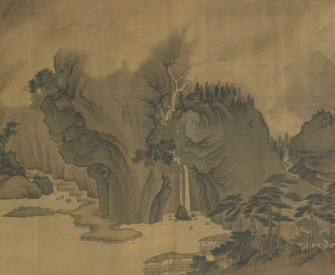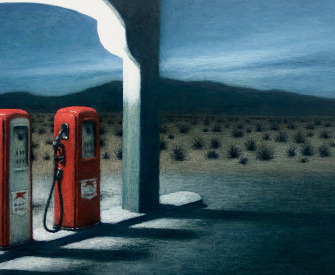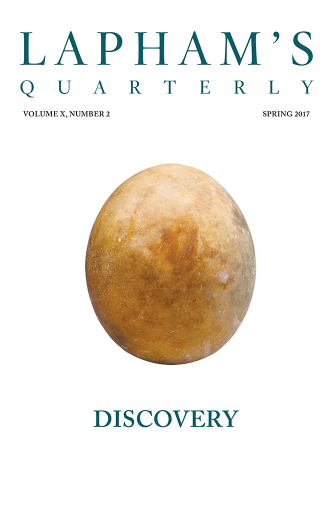Water has many ways of reminding us that when we are in it we are out of our element.
—Christopher Hitchens, 2008
River Landscape, by Jan Pieter Veth, 1878. Rijksmuseum.
Water attracts trouble. Time and again this ubiquitous and vital substance becomes the subject of controversial claims. The latest is about “raw” or “live” water, consumed directly from natural springs with no treatment or purification.
It’s largely a Silicon Valley thing. About thirty dollars will buy you five gallons from the Oregon-based company Live Water.
Sure, raw water might be full of other stuff like bacteria, algae, and minerals. But these, say devotees, are good for us—unlike the antimicrobial agents and additives in tap water or the plastic additives leached into bottled water. Fluoride, added to tap water for dental health, has a particularly long history of health scares and conspiracy theories; in the 1950s some said fluoridation was a communist plot to undermine the health of Americans. Raw-water advocates contend that fluoride is neurotoxic even at very low levels, although there’s no evidence of that.
I’ll happily attest that spring water straight from the source can be splendid—if you have the right source. But no law of nature prescribes it free from nasty pathogenic bacteria such as Shigella or parasites like Giardia. “I can’t stress enough how many lives have been saved because of functioning water and wastewater treatment facilities,” writes Gail Teitzel, editor of the journal Trends in Microbiology.
At any rate, raw water hardly qualifies as the “purest substance on the planet,” as it has been advertised. If that were so, whither the assertions that water is “so much more than just H2O molecules” and that purified water (here called “refined H2O,” which is entirely harmless) is “dead”?
It’s all so confusing. Notions of purity seem to have come unstuck from any conventional definition of that word. But where water is concerned, such dissonances shouldn’t surprise us. While clothed in scientific-sounding language, the rhetoric of the raw-water movement taps into an ancient discourse about the values of water. It is indeed “much more than just H2O molecules” because it has nurtured human civilizations throughout time. It is a sacred substance, and in their confused and sometimes misleading way, raw-water enthusiasts are at least attempting to honor that legacy.
When science advances in ways that challenge old beliefs, what results is often not simply the displacement of one by the other. Some beliefs don’t persist just because they haven’t yet been disproved. When they serve a deep psychological purpose, they’re likely to evolve to accommodate new information. Water demonstrates this again and again.
It is the original purifier. “If I were called in / To construct a religion,” wrote poet Philip Larkin, “I should make use of water.” By baptism it cleanses the believer for a life reborn; blessed by a priest, it confers protection from evil. The tensions of the Israeli-Palestinian conflict have been exacerbated by water issues not only via restrictions placed on Palestinian access to aquifers in the West Bank but also by the collision of water values: some Muslims, for whom the ritualistic use of water is of profound importance, regard Israeli use of water resources as profligate and negligent. (Of course, Jewish tradition also advises respect for water.) In 1871 the anthropologist Edward Burnett Tylor described how water’s sacredness seemed to make it invulnerable to contamination in the Middle East: the faithful Persian “may be seen by the side of the little tank where scores of people have been in before him, obliged to clear with his hand a space in the foul scum on the water, before he plunges in to obtain ceremonial purity.” It would take a powerful belief in water’s self-cleansing propensity to keep Hindus taking purifying dips in the dreadfully polluted Ganges.
Science, you might think, can clear (if not clean) these things up. A good chemical and microbiological test will reveal exactly which noxious substances a sample of water might contain and in what doses. But scientific studies have sometimes supplied an apparent rationale for sustaining the mystical attributes of plain old H2O—such as the “memory of water.”
At a rather strange conference on water in 2004, I met the French immunologist Jacques Benveniste. He was charming, witty, and seemingly comfortable in his role as scientific pariah. Benveniste was convinced that he had been “punished” for the embarrassment he had caused the editor of Nature, the august science journal that published his paper on the so-called memory of water in 1988.
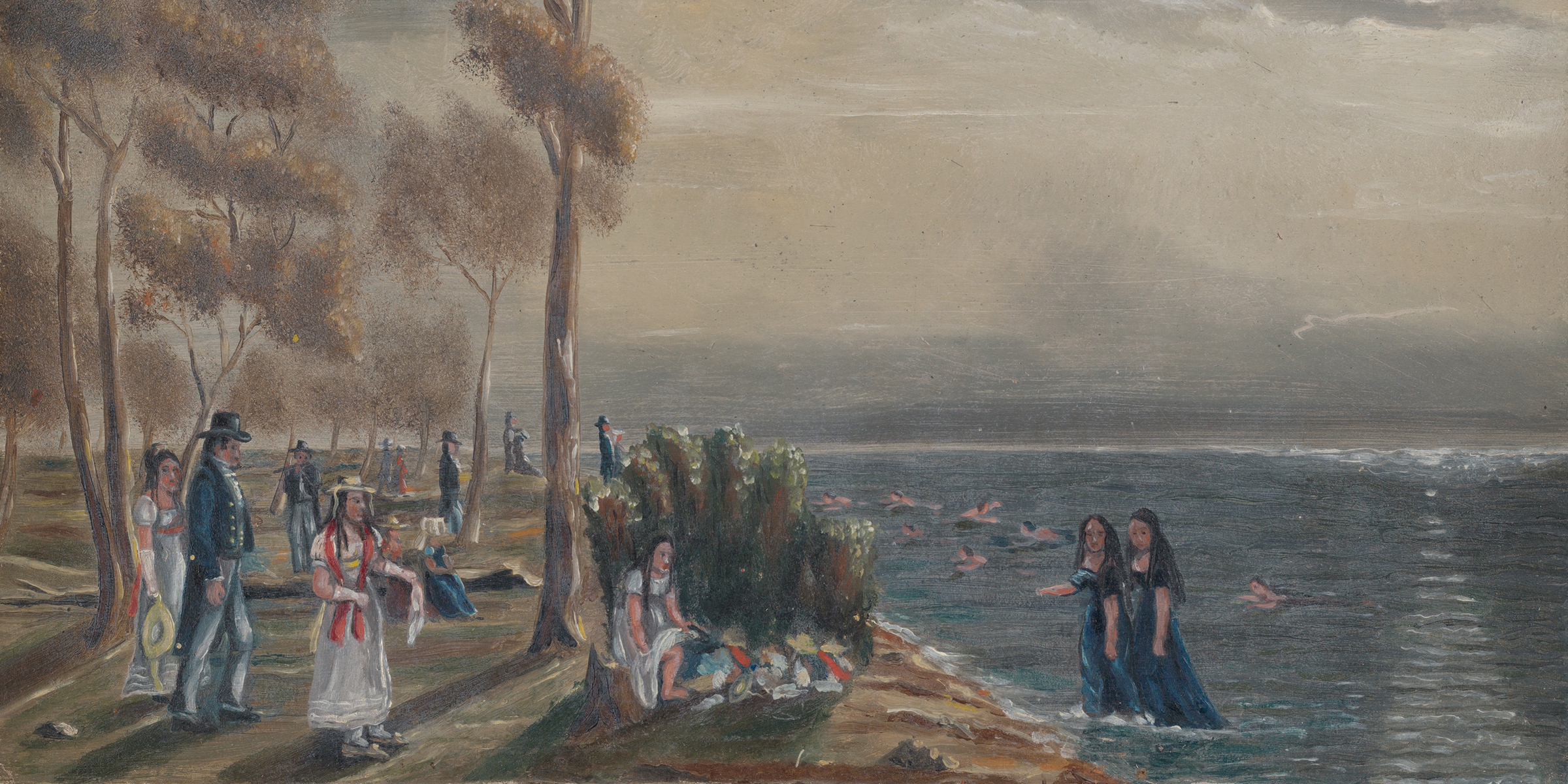
Bathing Party, by William P. Chappel, c. 1875. The Metropolitan Museum of Art, The Edward W.C. Arnold Collection of New York Prints, Maps, and Pictures, bequest of Edward W.C. Arnold, 1954.
I had joined the editorial team at Nature just weeks after its publication, and so had a ringside seat for the entertainment that followed. Far from opposing Benveniste’s paper, Nature’s editor, John Maddox, had pushed it into print against the instincts of his staff. If Maddox had a feud with Benveniste, it was certainly not an establishment-versus-outsider conflict but was more a spat between two mavericks. Maddox’s “investigation” of Benveniste’s research after the paper was published was unconventional, to say the least: he traveled to the French lab to see attempts (ultimately unsuccessful) to replicate the findings, accompanied by a specialist in scientific fraud and the professional magician and “pseudoscience debunker” James Randi.
Benveniste’s team had reported studies of one component of our cells’ immune response: the release of the chemical histamine from certain types of white blood cells when they encounter an allergen. The researchers could provoke this response using a protein molecule called an antibody that attached itself to the cells’ surface. But because the cell response sometimes seemed out of proportion to the amount of antibody present, they tried systematically diluting the antibody and seeing how the cells reacted.
What they found made no sense according to the standard principles of chemistry. As dilution steadily reduced the amount of antibody, the activity of the cells didn’t fall off but instead kept resurging. At first glance this rise and fall looked random, but Benveniste and colleagues discerned a pattern within it: an approximately regular oscillation of activity reappearing at certain intervals of dilution. What’s more, this behavior persisted up to an extremely high level of dilution: so dilute, in fact, that there should not have been a single antibody molecule left in the solution. The French team concluded that somehow the water was “remembering” the presence of the antibody long after it had been diluted to nothing.
The controversy caused by the paper’s publication in the world’s most prestigious scientific journal wasn’t just about the apparent clash with what all scientific experience would lead one to expect. Biological activity in a solution of some ingredient diluted to the vanishing point seemed to vindicate the claims made by homeopathy, which employs ultrahigh dilution of the “active” compound.
Ever since its introduction in the mid-eighteenth century, homeopathy has defied conventional scientific wisdom. Its inventor, German physician Samuel Hahnemann, claimed that it cured disease by treating “like with like.” The cure comes from an ingredient that, if administered in more than a “homeopathic” dose, would cause the disease or something like it. Homeopathic remedies were prepared from some highly toxic substances, such as arsenic and belladonna, but such was the dilution that they caused no ill effects. No study has ever shown convincing evidence that homeopathic medicines work beyond the placebo effect. But in Hahnemann’s time, many conventional medicines were also useless—and sometimes so positively harmful that giving patients nothing but water may have seemed effective in comparison.
All water has a perfect memory and is forever trying to get back to where it was.
—Toni Morrison, 1987Some homeopaths still seek vindication in Benveniste’s “memory of water.” But his results were never repeated in a careful and convincing experiment. Unless the results were fabricated (which I do not believe) or bungled, something odd really did happen in Benveniste’s experiments. But cell biologists know how unpredictable living cells are. The research is a textbook case of what American chemist Irving Langmuir in 1953 christened “pathological science”: it found a phenomenon that was barely detectable, hard to repeat, conflicts with all previous experience, and is explained with arbitrary invention and defended with ad hoc excuses.
I believe Benveniste was sincere in his convictions. But he made it hard to respect that sincerity. Rather than trying to systematically pin down how his strange findings had come about by simplifying his experimental system, he investigated ever-more complicated and uncontrollable manifestations of the alleged memory of water, testing his high-dilution solutions on rabbits and plants. He ended up claiming he could use radio waves to program biological activity directly into water according to what he called “digital biology.” Water, he said, acts as a “vehicle for information”—a receptive medium of infinite capacity and versatility.
There is something wonderfully alluring about the idea of a universal medicine in unlimited supply. Water is, after all, essential for life, and a shot of it can be deliciously reviving. It’s no wonder that it should be reimagined as a panacea. “We attribute to water virtues that are antithetic to the ills of a sick person,” wrote French philosopher Gaston Bachelard in his 1942 treatise on the poetics of water, Water and Dreams. “Man projects his desire to be cured and dreams of a compassionate substance.”
There is no better encapsulation of water’s sacred mythology than that conjunction: a compassionate substance. Chemists might balk at this juxtaposition: as though mere chemical compounds could have such attributes! But chemists do it themselves, recognizing the mythic dimension of gold when they call it a “noble metal” (they quietly redefine noble to mean “unreactive,” but don’t be fooled). Some material components of our world have, through their constant presence in history, acquired psychic associations. Bread and grain are more than sustenance, air more than a mix of gases, diamond more than an optically transparent solid. Water is indeed not just H2O.
That’s true even in chemical terms—and therein lies water’s potential for spawning pseudoscience. For one thing, water is a fabulous solvent; things dissolve in it so readily that it’s all but impossible to keep them out. Water soaks up oxygen and carbon dioxide from the air, and that makes plant and animal life possible below the ocean surface. Even the atoms in water itself aren’t all united as H2O molecules. At any moment, a small proportion of them have fallen apart into electrically charged fragments, hydrogen and hydroxide ions; an excess of one or the other turns the water acidic or alkaline, respectively.
Besides, the simple chemical formula H2O hides a formidable complexity at the molecular scale. Water molecules may form weak chemical links with one another, called hydrogen bonds, and via these unions—which are constantly being made and broken—the molecules in liquid water become joined into a gigantic network that is constantly shifting, breaking, and reforming, arranging the molecules into temporary structures and clusters with less randomness than is seen in many other liquids.
Water isn’t unique in forming hydrogen bonds, but it is the only common substance that can be joined by these gentle, frangible molecular handclasps into a three-dimensional network. Most liquids are little more than a disorderly scrum of jostling molecules. But water is delicately poised between order and disorder, constantly adopting a defective version of the framework structure that, in ice, immobilizes the water molecules into crystalline regularity.
It’s extremely hard to find the right scientific language to describe this dynamic state, and molecular scientists who study water still debate how to do that. This leaves an ambiguity about the structure of water that allows superficially plausible pseudoscience—and its relative, pathological science—to slip in.
In the mid-1960s a team of scientists in the Soviet Union led by the distinguished physical chemist Boris Deryagin reported they had discovered a new type of water that formed when it was contained in very narrow glass capillary tubes. This stuff didn’t flow like the ordinary liquid but had a gummy consistency. They called it “anomalous water.”
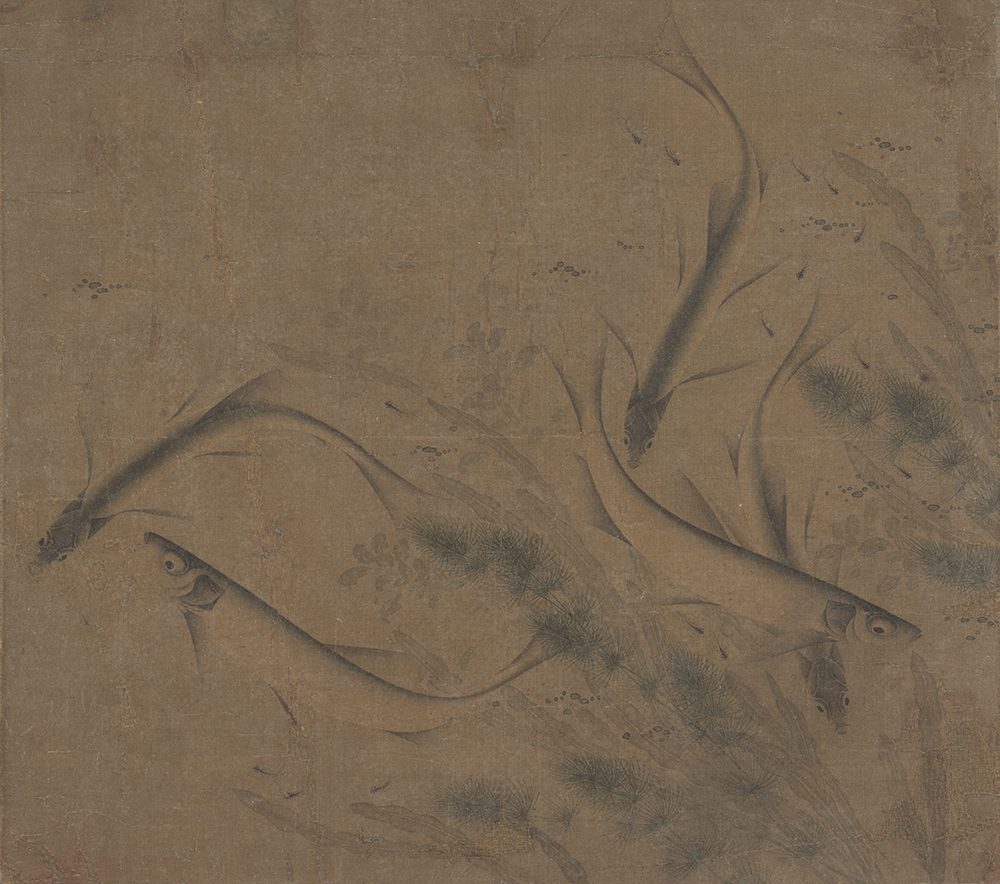
Fish at Play, attributed to Zhao Kexiong, twelfth or thirteenth century. The Metropolitan Museum of Art, John Stewart Kennedy Fund, 1913.
Soon other groups reported experiments that seemed to verify the claim, and it was suggested that this new form of water might arise from a more robust form of hydrogen bond linking the H2O molecules into a kind of polymer. It became known as polywater.
Yet these ideas didn’t fit with standard thinking about what water should be like, and they were hotly contested over the next several years. Eventually most researchers accepted that what the Soviets had seen was a solution contaminated by impurities, perhaps silicate material leached from the tubes’ glass walls—“polycrap,” as one critic put it. By 1973 Deryagin himself had capitulated to this interpretation, and polywater was dismissed as bad science—or another example of pathological science.
The furor about “cold fusion” is yet another pathological episode that hinged to some degree on the real mysteries of water’s properties. In 1989 two chemists claimed to have conducted energy-releasing nuclear fusion on a laboratory workbench in a beaker of dissolved salts, drawing strength from old ideas about water as fuel, which also sustain perennial tales of vehicles and engines that run on water alone.
These theories are part of an old tradition. In some ways it harks all the way back to the transmutation of water by holy blessing to make it a potent prophylactic against the devil and a solvent for purifying and washing away sin.
In the eighteenth century, the German physician Franz Anton Mesmer offered “cures” involving the insertion of magnetic rods into baths in which his patients were immersed. Water seemed to become a conduit for an “animal magnetism” that Mesmer claimed to be able to command and channel. The belief that water can be altered by magnetism persists. You can still buy magnetic devices that allegedly counteract the effects of hard water and prevent scaling of kettles. There’s no reason to suppose they work and no scientific argument for why they should. Nevertheless, I was once assured by a respected physicist that stirring a glass of water with a magnetic rod changes its viscosity and mouthfeel.
Water energized to some peculiarly “vital” state is an old dream, too. In the 1920s and 1930s, an Austrian forest warden named Viktor Schauberger claimed he could make what he called “living water” by sending it down specially constructed channels to activate it with the energy of vortices created by the flow. He developed a theory for how these vortices could release energy by inward bursts he called implosions, which could develop a thrust that might power flying devices. It was rumored that Schauberger was forced to work on secret weapons for the Nazis during World War II to exploit this principle. After the war, entrepreneurs brought him to the U.S., but he returned to Austria, convinced that the military was trying to steal his ideas.
Far water cannot quench near fire.
—Japanese proverb,New scientific understanding simply creates new niches where these old notions may flourish. I once spent a couple of hours with a very famous pop singer hosting a group of Russian scientists in her elegantly minimal London residence while the scientists sought to persuade me that they had developed some manner of treating water—I think it involved electromagnetic fields—to “neutralize radioactivity” and thereby decontaminate the lakes around Chernobyl. When I explained to the assembled company that radioactive decay does not really respond to this sort of intervention, I was offered an explanation based on quantum mechanics. I have heard nothing of this solution for radioactive decontamination since, but the technique (“quantum resonance technology”) resurfaced for the production of yet another brand of health-giving, and expensive, bottled water, Kabbalah Water. I sense a pattern here.
Supercharging water to confer restorative virtues is a recurring theme in the mystical pseudoscience associated with “hydration.” The company behind Penta Water—a bottled water produced in Southern California—originally claimed it had been “restructured” at the molecular level, which somehow produces better hydration. They no longer advertise that idea but instead boast of a formidable series of purification steps that, for fans of raw water, must leave Penta Water as dead and sterile as could be imagined. (Ultrapure water, used for industrial processing of semiconductors, is in fact said to taste bitter, and to leach minerals from the body to a degree that won’t do your health any favors, even if it’s not as lethal as it is sometimes claimed.)
But high tech is not always required to “improve” water. The Japanese writer Masaru Emoto claimed in his best-selling book The Hidden Messages in Water (released in English translation in 2004 and popularized the same year in the film What the Bleep Do We Know!?) that human consciousness can influence water at the molecular level thanks to the transmission of emotional “energies” and “vibrations.” The effects, he said, can be seen in the transformative influence of Buddhist prayer on the forms taken by water as it crystallizes into ice. Music has this effect too: crystals exposed to Elvis singing “Heartbreak Hotel” split in two.
This is indeed industrial-strength water pseudoscience. But it has traction because—whether knowingly or not—it was planted in such rich soil.
Nothing better illustrates the coexistence of old beliefs and new science in the study of water than the way many of today’s water companies still employ dowsing, with handheld divining rods, to locate underground sources such as pipes or aquifers. When British science blogger Sally Le Page revealed the ongoing practice in 2017, it sparked a furious debate about the value of dowsing. Perhaps the most revealing aspect of the affair, however, was the merry insouciance with which water companies and their engineers admitted to sometimes taking up the bent rods—as though this was simply a good, old-fashioned, and cheap alternative to satellite-surveying methods. They use dowsing, they explained, because it works for them.
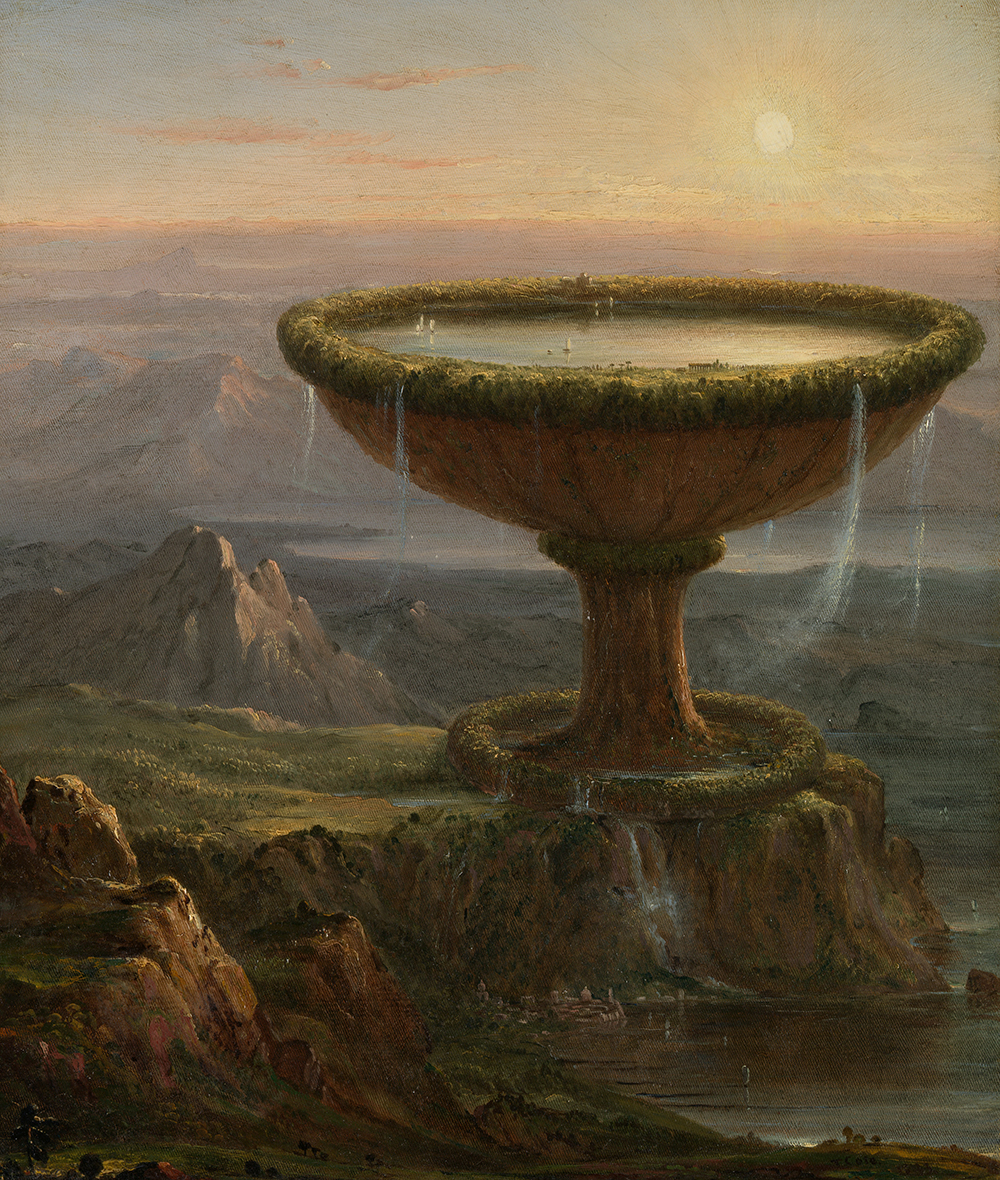
The Titan’s Goblet (detail), by Thomas Cole, 1833. The Metropolitan Museum of Art, Gift of Samuel P. Avery Jr., 1904.
But as the old adage goes, the plural of anecdote is not data, and the most extensive tests of dowsing under scientific conditions, conducted in Germany in the 1980s, showed that it located water sources no more reliably than chance. This is hardly surprising, for there is no known physical force or mechanism that could explain why water flowing underground or under a floor should cause rods clasped in the hand to move. The only plausible reason why water might be found this way with better than chance efficiency is that the dowser has developed a good intuition for signs of possible water sources (the nature of vegetation, maybe?) and subconsciously causes the rods to cross.
The tradition of water divining is ancient; the Roman writers Pliny the Elder and Vitruvius mention it. But it was not until the sixteenth century that Georgius Agricola, a German expert on mining, mentioned the use of handheld rods or twigs for earth divining; he offered a skeptical appraisal of how miners used it to locate mineral and ore veins. There are records of the use of twigs to find water from around the same time.
Dowsing, like astrology, retains aspects of a quasi-animistic vision of the natural world, with roots in the early Renaissance tradition called natural magic. The world of the natural magician was a web of hidden (occult) forces woven by God with design and purpose. This design was thought to be imprinted on nature and could be “read” by those who knew how—so that, for example, herbs with particular healing powers resembled the parts of the body they could be used to treat. In such ways, the cosmos is imbued with properties that make human habitation possible. Our existence within it is no mere accident, for our very presence awards it meaning.
That was doubtless a consoling thought when Copernicus’ heliocentric theory threatened to dislodge the Earth from a central position in all creation. But this notion also has a modern scientific equivalent, and you might not be surprised to hear that it makes use of water. In 1913 the American biochemist Lawrence Henderson argued that water seems uniquely “fit,” in the Darwinian sense, to act as the solvent of life. “Water, of its very nature,” he wrote in his book The Fitness of the Environment, “as it occurs automatically in the process of cosmic evolution, is fit, with a fitness no less marvelous and varied than that fitness of the organism which has been won by the process of adaptation in the course of organic evolution.” In water’s unusually high capacity to hold heat, keeping lakes and oceans at a stable temperature through the seasons; its large “latent” heat of evaporation and condensation, which helps redistribute heat across the globe as the sea surface evaporates and rain clouds condense; its power as a solvent delivering minerals to organisms; its large surface tension, which lets it rise high above the ground in the capillary systems of plants; and other properties that mark it out from other liquids, water seemed, in Henderson’s view, just what is needed to sustain life on our planet.
I drink for the thirst to come.
—François Rabelais, 1535There’s a clear invitation to see this as an “argument from design” for the divine creation of the cosmos. Henderson refrained from any direct statement about whether water is indeed “purposeful” in this sense. But scientists today continue to ask: Is water indeed somehow uniquely suited to acting as life’s matrix—or does it just look that way to beings adapted to living in a watery world?
Here again the old idea that water’s agency is somehow bound up with human existence finds new apparel from the science of the times. If water had an anthropocentric “purpose” in the twentieth century, it would have to be expressed in the languages of physical chemistry and Darwinism. That Darwinian theme is echoed today in the claim of raw-water enthusiasts that we are “adapted” to the waters of natural springs, not those artificially purified of all other ingredients. There’s no factual basis for that assertion—there would be no adverse consequences from drinking only filtered water, but you’d suffer plenty from drinking water that natural selection has populated with microorganisms—although it makes sense against the backdrop of a belief in a teleological universe.
How dismayed should we be by the survival of mystic ideas about water? While there can be a hectoring edge to the advertisements warning that you will not be properly hydrated without an expensive brand of bottled water, most people are unlikely to be taken in by it. Rather, such fads and fashions are typically just one expression of a lifestyle choice. Beliefs about water here serve a symbolic function: they express, in what might sometimes be a clumsy and garbled way, an ancient sense of why water is important beyond its chemical formula.
And it is, of course. All cultures have a tradition of respect for water because that is how they survived. Sacred springs exist in many cultures, and our stories and philosophies encourage care of water resources. “The highest good is like water,” wrote Lao-tzu in the foundational text of Chinese Taoism. Water offers a metaphorical model for good conduct both in that tradition and in Confucianism. The Hani, Deang, and Naxi ethnic minorities in Yunnan Province in China fetch water at the dawn of the new year to bring good luck and prosperity. Pools and wells all over Southeast Asia are said to be guarded by dragons, as though to say, You abuse water at your peril.
The price we pay, though, for these important and indeed sacred associations of water is that they may distort, even traduce, our scientific understanding of this decidedly strange substance. This is not, as is often implied, because New Age mystics, health gurus, and Gwyneth Paltrow are drowning out the voices of sober scientists. For as we’ve seen, science is itself vulnerable to our deep-seated intuitions about water. We haven’t seen the last of strange “water science.”
The fact is that, when we study water, we study dreams and myths. As Bachelard discerned, we conjure up reveries of birth, of milk and blood, of change and flux, of healing and succor, but also Poe’s nightmarish maelstrom and the deathly tug of the Styx. “One drop of powerful water,” he wrote, “suffices to create a world and to dissolve the night.” No microscope or spectrometer can contain all of that; it leaks off the slide and out of the frame, and flows everywhere.
